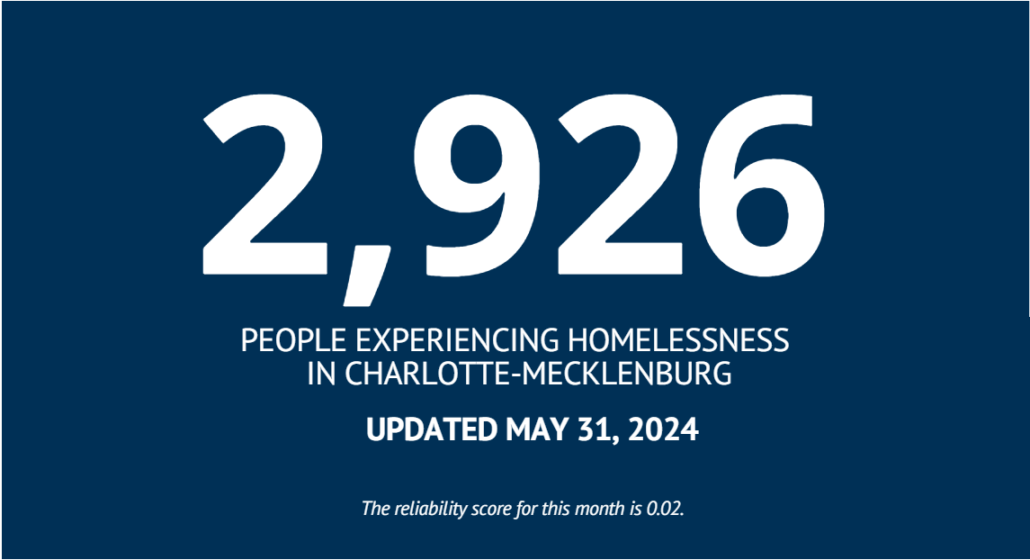Mary Ann Priester
Senior Management Analyst
Mecklenburg County Community Support Services
Almost five years ago, Mecklenburg County Community Support Services introduced the “One Number”. Since its inception in 2019, the “One Number” has served as the primary benchmark for the number of people experiencing homelessness in Charlotte-Mecklenburg.
Generated from the Homeless Management Information System (HMIS), the One Number encompasses individuals enrolled in Emergency Shelter (ES), Transitional Housing (TH), Street Outreach (SO), Permanent Housing (PH) (if no move-in date to housing is recorded yet) and Coordinated Entry (CE) programs in HMIS. It includes both those experiencing sheltered homelessness and a portion of those experiencing unsheltered homelessness. It also provides a comprehensive By-Name List of persons experiencing homelessness in Charlotte-Mecklenburg.
One Number data not only provides an overall count of homelessness in Charlotte-Mecklenburg, but also can be broken down by household and population type and disaggregated by demographic characteristics such as race, ethnicity, gender, and age. In addition, One Number data also facilitates the examination of inflow and outflow patterns associated with homelessness. The Housing Data Snapshot, the hub for the latest data related to housing and homelessness in Charlotte-Mecklenburg, highlights inflow to (Newly identified, Returns from Permanent Housing, Returns for Inactivity) and outflow from (Exit to Permanent Housing, Exit to Inactivity), homelessness.
This week’s blog post provides an overview of the One Number update, what’s changed, the latest trends and analyses; and what this means for Charlotte-Mecklenburg.
LATEST DATA & TRENDS
As of May 31, 2024, there are 2,926 individuals experiencing homelessness in Charlotte-Mecklenburg. This total includes 1,850 single individuals, 149 unaccompanied youth, 309 households with minor children (totaling 1,017 people), and 34 families with multiple adults (totaling 72 people). Included in the total of 2,926 individuals, 192 are homeless Veterans, and 642 are individuals who are experiencing chronic homelessness.
Based on these data, the minimum number of people experiencing homelessness right now (and therefore, the minimum number of housing units and/or subsidies needed) in Charlotte-Mecklenburg is 2,926.
Considering inflow (into homelessness) and outflow (out of homelessness), here are some noteworthy trends:
- Between April and May 2024, there was a 195 person increase in the total number of people experiencing homelessness. There has been a 20% (or 493 person) increase in overall homelessness since July 2023. As context, during this period there have been significant investments in expanding street outreach and coordinated entry capacity. It is possible that the rise in homelessness is due to, at least in part, enhanced capacity to connect with people experiencing unsheltered and sheltered homelessness in Charlotte-Mecklenburg.
- In May 2024, 882 individuals entered homelessness (inflow) and 632 people exited (outflow). Of the 882 individuals entering homelessness, 76% (667) were newly identified, whereas 9% (78) represented returns to homelessness from permanent housing and 16% (137) returned from an inactive status. Of the 684 individuals exiting homelessness, 44% (281) moved to permanent housing and 56% (351) exited homelessness to an inactive status, which means that they had not been engaged in services for the previous 30 days.
- Between April 2024 and May 2024, homelessness increased among all household types and subpopulations. The number of families with minor children increased by 28 households; the number of families with multiple adults increased by 6 households; the number of single individuals increased by 240; and unaccompanied youth increased by 32. In addition, the number of Veterans experiencing homelessness increased by 13; and people experiencing chronic homelessness increased by 23 individuals. Finally, the median number of days it takes to exit homelessness into housing decreased from 290 days to 288 days and the average number of days it takes to exit homelessness into housing increased from 532 days to 638 days. The median tells us the typical number of days it takes to exit homelessness into housing while the average includes long-stayers in shelter and people experiencing chronic homelessness.
- According to the most recent One Number data, disaggregated by race and ethnicity, individuals who identify as Black/African American continue to experience homelessness at rates much higher than their proportion of the Mecklenburg County population (79% vs. 33%) while individuals who identify as White, non-Hispanic experience homelessness at a rate much lower than their prevalence in the population (15% vs 47%). Individuals who identify as Hispanic/Latino have a prevalence of 4% in the homeless population but comprise 14% of the Mecklenburg County population; this reflects a possible underrepresentation of the people who experience homelessness in Charlotte-Mecklenburg and identify as Hispanic/Latino.
SO, WHAT
The One Number is the best snapshot available for the number of people actively experiencing homelessness in Charlotte-Mecklenburg. It provides the most accurate minimum number of people experiencing homeless and provides insights into the minimum number of housing units and subsidies needed today to address their homelessness. When disaggregated by household type and subpopulation type, these data can be used to inform person-centered interventions and system level strategies to address homelessness effectively in Charlotte-Mecklenburg.


